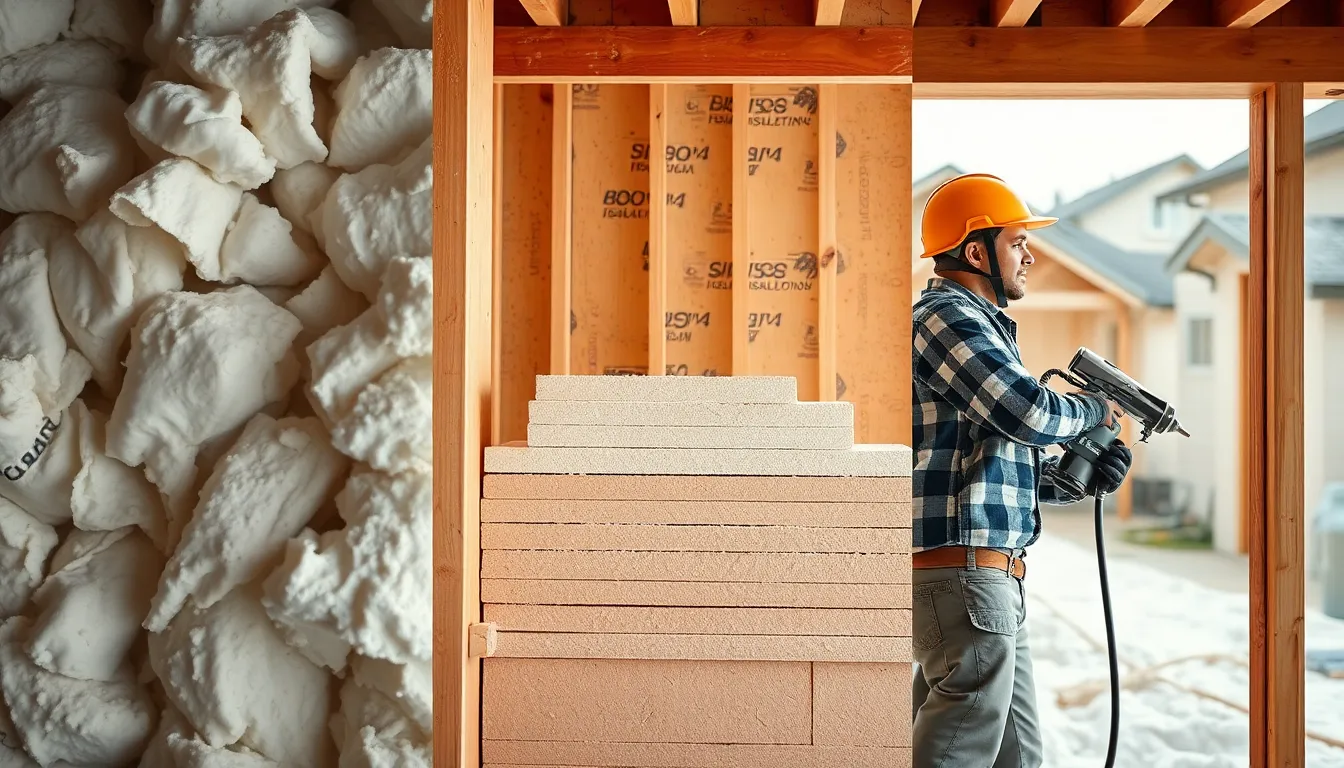Table of Contents
ToggleWhen it comes to keeping a home cozy, R-value insulation rating is the unsung hero. Think of it as the superhero of your walls, fighting off the evil forces of heat loss and energy bills. A high R-value means better insulation, and who wouldn’t want to wrap their home in a warm, energy-efficient blanket?
Understanding R-Value Insulation Rating
R-value insulation rating measures an insulation material’s resistance to heat flow. This value plays a crucial role in determining energy efficiency in homes.
Definition of R-Value
R-value quantifies the thermal resistance of insulation materials. Higher R-values indicate better insulation performance. Variables such as material type, thickness, and density affect the R-value. Common materials include fiberglass, foam board, and cellulose, each providing different insulation capabilities. Homeowners can compare R-values when selecting insulation to achieve optimal comfort and efficiency.
Importance of R-Value in Insulation
R-value significantly influences energy costs and comfort levels. Insulation with a high R-value minimizes heat transfer, keeping homes warm during winter and cool during summer. A well-insulated home reduces dependence on heating and cooling systems. Energy-efficient homes with appropriate R-values lower utility bills, contributing to long-term savings. Furthermore, understanding R-value helps in making informed decisions when renovating or constructing homes.
Types of Insulation Materials
Different insulation materials offer varying R-values. These materials influence energy efficiency and comfort levels in homes by providing effective resistance to heat flow.
Fiberglass Insulation
Fiberglass insulation ranks among the most common insulation types. It consists of glass fibers and has an R-value typically ranging from 2.9 to 4.3 per inch. This product is lightweight and non-combustible, making it suitable for various applications. Installation can occur in batts or rolls, and it’s often found in walls and attics. Its affordability adds to its appeal, allowing homeowners to balance cost with energy efficiency.
Foam Board Insulation
Foam board insulation serves as an effective option for many construction projects. With an R-value ranging from 3.8 to 6.5 per inch, it provides superior thermal resistance. Commonly used in exterior walls, foundation walls, and roofs, foam board is water-resistant and lightweight. Its rigid structure allows for easy installation and a reduction in thermal bridging. Many builders favor this material for both new constructions and renovations.
Spray Foam Insulation
Spray foam insulation offers excellent air sealing alongside its thermal resistance. This material achieves an R-value between 6.2 and 7.6 per inch, depending on its formulation. It expands upon application, filling gaps and cracks, which helps reduce air leaks. Homeowners often prefer spray foam for its ability to enhance energy efficiency effectively. While installation requires professional expertise, the long-term savings on energy bills can justify the initial investment.
Factors Affecting R-Value
Multiple factors influence the R-value of insulation, impacting its thermal resistance and overall effectiveness.
Material Thickness
Thickness plays a significant role in determining R-value. Generally, thicker insulation materials provide higher R-values. For instance, fiberglass insulation measures between 2.9 to 4.3 per inch. Foam board insulation achieves R-values of 3.8 to 6.5 per inch. Spray foam insulation, known for its excellent sealing properties, ranges from 6.2 to 7.6 per inch. Each additional inch of thickness typically adds to the insulation’s resistance to heat flow, increasing energy efficiency.
Temperature Variations
Ambient temperature significantly affects R-value performance. In colder climates, higher R-values become essential for maintaining comfort and lowering heating costs. As outdoor temperatures drop, inadequate insulation leads to increased heat loss. Conversely, in warmer climates, insulation must resist heat from outside to maintain indoor comfort, enhancing air conditioning efficiency. Understanding how temperature variations impact insulation effectiveness helps homeowners make informed choices.
Moisture Levels
Moisture levels directly affect the insulation’s R-value. High moisture content can reduce the effectiveness of certain materials, leading to a drop in R-value. For instance, cellulose insulation absorbs moisture, which can decrease thermal resistance. Spray foam insulation, however, generally resists moisture better, maintaining its R-value. Managing humidity levels contributes to optimal insulation performance, ultimately impacting energy bills and indoor comfort.
Choosing the Right R-Value
Selecting an appropriate R-value for insulation involves understanding specific needs and conditions. The right choice enhances energy efficiency, comfort, and cost savings.
Climate Considerations
Climate plays a significant role in determining the ideal R-value for insulation. Cold climates require higher R-values to reduce heat loss effectively, while warmer areas benefit from insulation that resists heat gain. For instances, an R-value of 38 is typical for attics in colder regions. Conversely, a value around 30 suffices in temperate zones. Homeowners should assess local weather patterns when deciding. Adequate insulation not only improves comfort but also reduces reliance on heating and cooling systems. Understanding regional climate characteristics enables informed decisions that lead to optimal energy performance.
Building Codes and Regulations
Building codes and regulations often dictate minimum R-values for insulation in different areas. These codes ensure safety, energy efficiency, and structural integrity for new constructions and renovations. For example, states like California require an R-value of at least 38 for attics. Adhering to local regulations prevents issues during inspections and promotes best practices in energy conservation. Homeowners must consult local building authorities to pull accurate code requirements. Compliance not only protects investments but also contributes to long-term savings on energy bills. Understanding these codes fosters informed choices for insulation installation.
Conclusion
Understanding R-value insulation ratings is vital for homeowners aiming to improve energy efficiency and comfort. By selecting the right insulation material with an appropriate R-value, they can significantly reduce heat loss or gain, leading to lower energy bills and enhanced living conditions. It’s essential to consider factors such as climate, material type, and local building codes when making insulation choices. Investing in high R-value insulation not only protects homes from temperature fluctuations but also contributes to long-term savings. With the right knowledge and careful planning, homeowners can create a cozy and energy-efficient environment that stands the test of time.





